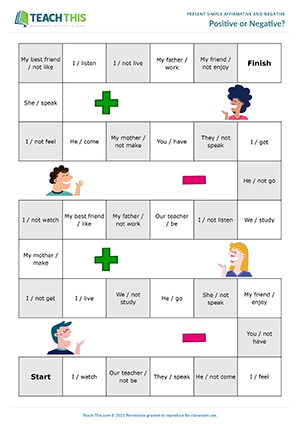OBJECTIVE
By the end of the lesson, students should be able to express ideas in oral and written way using the simple present tense by means of different activities.
WARM UP
Mime game related to verbs

GRAMMAR
The simple present tense in English is used to describe an action that is regular, true or normal.
We use the present tense:
1. For repeated or regular actions in the present time period.
- I take the train to the office.
- The train to Berlin leaves every hour.
2. For facts.
- The President of The USA lives in The White House.
- A dog has four legs.
3. For habits.
- I get up early every day.
- Carol brushes her teeth twice a day.
4. For things that are always / generally true.
- It rains a lot in winter.
Verb Conjugation & Spelling
The spelling for the verb in the third person differs depending on the ending of that verb:
1. For verbs that end in -O, -CH, -SH, -SS, -X, or -Z we add -ES in the third person.
- go – goes
- catch – catches
- wash – washes
- kiss – kisses
- fix – fixes
- buzz – buzzes
2. For verbs that end in a consonant + Y, we remove the Y and add -IES.
- marry – marries
- study – studies
- carry – carries
- worry – worries
NOTE: For verbs that end in a vowel + Y, we just add -S.
- play – plays
- enjoy – enjoys
- say – says
Negative Sentences in the Simple Present Tense
To make a negative sentence in English we normally use Don't or Doesn't with all verbs EXCEPT To Be and Modal verbs (can, might, should etc.).
- Affirmative: You speak French.
Negative: You don't speak French.
You will see that we add don't between the subject and the verb. We use Don't when the subject is I, you, we or they.
- Affirmative: He speaks German.
Negative: He doesn't speak German.
When the subject is he, she or it, we add doesn't between the subject and the verb to make a negative sentence. Notice that the letter S at the end of the verb in the affirmative sentence (because it is in third person) disappears in the negative sentence. We will see the reason why below.
Negative Contractions
Don't = Do not
Doesn't = Does not
Doesn't = Does not
I don't like meat = I do not like meat.
There is no difference in meaning though we normally use contractions in spoken English.
Word Order of Questions with Do and Does
The following is the word order to construct a basic question in English using Do or Does.
| Do/Does | Subject | Verb* | The Rest of the sentence |
|---|---|---|---|
| Do | I / you / we / they | have / need want etc. | a new bike? |
| Does | he / she / it |
Examples of Questions with Do and Does:
- Do you need a dictionary?
- Does Mary need a dictionary?
Short answers with do and does
| Do they like chocolate? | Yes, they do. | No, they don't. |
| Does he like chocolate? | Yes, he does. | No, he doesn't. |
ACTIVITIES
WRITING
Change the sentences to affirmative ( + ), negative ( - ) or interrogative ( ? ).
1. Do you go to the movies every weekend? ( + ) _________________________________
2. We buy vegetables at Olimpica. ( - ) ____________________________________
3. She plays basketball on Friday. ( - ) ____________________________________________
4. Does Tim read newspapers? ( + ) __________________________________________
5. My friends and I go to Plaza del Sol at the weekends. ( ? ) ___________________________
6. Ray doesn´t like the champeta. ( ? ) ___________________________________________
Complet the sentences.
1. Nigel _________________ ( +, play ) hockey.
2. My brother ________________ ( -, have) school tomorrow.
3. The bus __________________ (+, leave) at 5 o´clock.
4. My mom ____________________ (+, watch) TV every night.
5. My dad __________________ (-, play) soccer.
6. Rachel __________________ (-, eat) at the school cafeteria.
Look and unscramble the questions. Then write the answers.
1. JFK Middle School? / she / go / to / does _______________________________
2. today? / we / do / chemistry / have ____________________________________
3. they / English / do / speak ___________________________________________
4. you / in the afternoon? / play / do / basketball ____________________________
READING
LISTENING
Listen the song and complete
SPEAKING
Round table about the students´rights and duties
Game
n this engaging present simple board game, students make true present simple affirmative or negative statements from prompts. Give each group of three or four a copy of the game board, a dice and counters. The players place their counters on the start square. The players then take it in turns to roll the dice and move their counter along the board. When a player lands on a square, they make a true present simple affirmative or negative statement using the prompt on the square. If need be, the player indicates who they are talking about, e.g. 'He doesn't come from Spain'. The other group members listen to the sentence and decide if it is grammatically correct or not. If it is, the player stays on the square. If not, the player must go back to their previous square. If players land on the same square, they are not allowed to repeat another student's sentence. The first player to reach the finish wins the game. Afterwards, review the students' sentences as a class and give feedback.

Retrieved by https://www.teach-this.com/grammar-activities-worksheets/present-simple-affirmative-negative

No hay comentarios:
Publicar un comentario